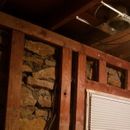Stone house – insulating
We are rehabbing a stone house built in 1944. Walls of bsmt and first floor are 18″ thick limestone. there are stud walls around exterior but they are facing the stone, not perpendicular to it. We have an inch to 2 inches of space between studs and stone. What is best way to properly insulate without having moisture become an issue. We plan to use drywall as wall material but.we are uncertain which would be best for this application. All drywall can grow mold so we want to limit that possibility by properly insulating the stone wall. Thanks!
GBA Detail Library
A collection of one thousand construction details organized by climate and house part











Replies
Jim,
Q. "We have an inch to 2 inches of space between studs and stone. What is best way to properly insulate without having moisture become an issue?"
A. Use closed-cell spray polyurethane foam. Make sure that the installer insulates the gap between the studs and the stone wall.
Jim,
If you are looking for non SPF options, you can check out this:
//m.etiketa4.com/article/how-to-insulate-a-basement-wall
A stone house is very close to a basement wall. Anything that works in the basement will not cause issues for you.
If you are OK with loosing a bit of interior space, installing rigid insulation over the strapping and installing drywall with long screws directly over the foam is pretty easy DIY. 2" of polyiso is a bit less R value than spray foam but because it is continuous over the whole surface, it will insulate better than the 2" of SPF between the strapping.
Don't trap your existing wood between a reservoir-cladding (your stone) and anything without first putting an air barrier and vapor retarder between the stone and the existing wood. +1 on closed cell spray foam that will flow between the stone and existing wood and serve this purpose.
https://www.buildingscience.com/documents/information-sheets/reservoir-claddings